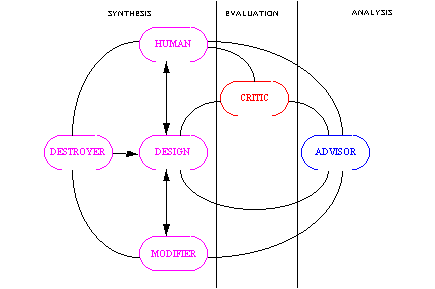2.2 AGENTS OF SYSTEMATIC DESIGN
2.2.2 A TAXONOMY OF AGENTS
As indicated before, automated design processing can be considered in terms of text processing, incorporating mechanisms to facilitate idea formation and communication. Distinctions among such well-used systems as word processors or desktop publishers have created a common nomenclature which could be applied to the subtleties of advisor systems.
Referring to the word processing analogy of the Introduction, an advisor may be compared to a spelling check utility. The usefulness of the utility is limited if all it does is evaluate a body of text and state that a given word is not in the internal dictionary. At this point, the utility is merely a critic, passing judgement without offering advice. An analysis of the word and a conceptualizing of alternatives incorporates a more useful element into the utility. In the case of the word processor, words approximate to the misspelled one are found and suggested. In effect, alternative concepts are offered; advise has been given.
Offering a set of possibly correct words is not the same as incorporating the advice into the text body. Choice of an alternative word and consequent modification of the text body is a task relegated to the human component, or perhaps some autonomous modifier component. The synthesis of advice into a design is essentially a process independent of the evaluation of text and the generation of advice.
In addition to a spelling checker, word processing advisors include grammar checks and thesauruses. These, too, demonstrate distinctions between evaluation of text to provide a critique, analysis of the critique and text to provide advice, and synthesis of the advice into the original body of text.
Figure 8 illustrates class relationships under the systematic design model. Note that the Critic class comprises the evaluation/interaction stage, the Advisor class comprises the analysis/conceptualizing stage, and the other classes comprise the synthesis/implementation stage of design.
Figure 8 Agents of a Systematic Design Processing System

The following classes and descriptions are sufficient to formally define a design processing system, specifically one with critique and synthesis elements.
- Design: Shared memory representation, which includes data and operations to create, update, modify, and delete that data.
- Critic: Evaluates a design and indicates areas that need to be reconsidered. Theories and models guide the evaluation.
- Advisor: Analyzes areas of a design offered for reconsideration and generates advice. An advisor uses certain "techniques" to conceptualize changes to a design or portion of a design, or employs a technique to create and offer the changes themselves. In essence, the advisor offers the specifications for change in the state of a design. (The advisor, in this respect, could offer the specifications for an initial state as well.)
- Because it is likely that advisors may work with alternate representations, it is up to the modifier to synthesize results into the original model. Note that the advisor depends on the initial evaluation of the critic. As such, any reference to an advisor necessarily includes the critic.
- Modifier: Decides on alternatives and modifies the model to incorporate design alternatives. Only the modifier and human can directly update and alter a design.
- Human: Directly alters the design, possibly mindful of critical feedback, and incorporates design alternatives into the original design. The human agent has the capability to do anything the other agents can do, although perhaps not as well.
- Destroyer: Removes a design from consideration within the system, severing any spacial or temporal relations the design may have with the current state of the system. In multiple design systems, it may be responsible for killing off designs, but the modifier or human may still be ultimately responsible for making the actual decisions.[1]
The part of the design model to be examined further is limited to the evaluation/interaction phase here. The connecting components of human, design, and advisor will also have to be included in any discussion of the evaluation phase.
[1] Although the Destroyer class is controversial, with some advocacy for its placement within the Modifier class, many operating systems from UnixTM to relational database management, consider deletion or removal to be substantially distinct from mere modification. Use of the destroyer is intentionally irrevocable, akin to death itself. It is the class of functions that assure uncluttered directories, free disk space, permanent reductions in problem space, and a deliberate end to the design-to-manufacturing iteration of obsolete artifacts. Death is as important and distinct in the design life cycle as the creation and modification agents themselves.